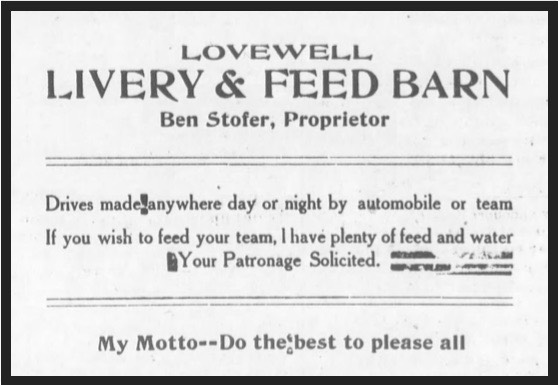Several years ago Dave Lovewell and I amused ourselves for months on end while we struggled to date the photo of a Lovewell family gathering by examining it closely for subtle clues.
The group portrait from “The Lovewell Family” shows two dozen people standing, sitting or kneeling on a lawn at Lovewell, Kansas, in front of a line of trees. Although the caption states that the picture was taken in May 1914, Dave and I both were skeptical. The landscape seemed rather desolate for springtime, and there was no occasion we could think of that might have warranted a large family gathering just then. Grant Lovewell is pictured holding a small child identified as his brother Frank’s daughter Freida, and their brother-in-law Ben Stofer clutches a bright, spherical object. How old is that little girl, we wondered, and could that have been a freshly-picked apple in Ben’s hand?
I think we finally settled on December 20, 1913, the date of Thomas’s 87th birthday, before finding a news item about a photographer from Courtland, “Wray the Face-Maker,” who announced that he was hurrying off to record Thomas and Orel Jane’s 50th wedding anniversary on April 1, 1916. The child who once seemed such a promising clue must have been misidentified decades ago, long after little Freida Lovewell died of a childhood ailment in the fall of 1914. And maybe that’s a baseball Ben Stofer is clutching - who knows?
Phil Thornton and I have been involved with a similar puzzle, trying to figure out the date of a recently-unearthed picture which shows a somewhat younger Thomas and Orel Jane posing at the edge of their garden at Lovewell. The picture from Mary Stofer’s photo album could have been taken no earlier than the summer of 1902, the first growing season since the introduction of Kodak’s rectangular-format Brownie camera. While cautiously labeling the picture as taken circa 1902, I have to admit that I’ve mentally woven an elaborate tale around it, imagining Thomas stopping in Laramie to purchase a chic Western ensemble to impress his cousin, Joseph Taplin Lovewell, when he visited the professor in Topeka that October.
Thomas had arrived in Wyoming early in the spring of 1902, and after filing a number of mining claims in August, he must have returned to Jewell County in September. I was heartened to find a news clipping which mentioned that Grant Lovewell had joined his father in Wyoming late that summer, accompanied by his brother-in-law, Ben Stofer. Perhaps when Thomas returned home ahead of the boys, Ben’s wife Mary grabbed her new camera and snapped a photo of her parents resting from their gardening chores. The evidence all fit together perfectly.
I experienced a moment of deja vu when Phil pointed out that the garden behind the couple looks rather lush and summery, not at all typical for September in northern Kansas. Drat. He’s right. Phil later posited that instead of spending the whole summer of 1902 in Wyoming, Thomas might have returned home at the halfway point. We know that he wowed attendees at the Jewell County Fair that year with his corn exhibit, but he didn’t necessarily have to show up in person to do so - only the corn had to put in an appearance.
Using information from various newspaper archives, Phil constructed what seems to be a pretty solid timetable of the traffic between Lovewell, Kansas, and southeast Wyoming in the first few years of the 20th century. A general-delivery letter waiting for Thomas at Laramie in September 1901 was the first breadcrumb on the trail leading to the pioneer's fabled Wyoming gold mine. For the next seven years local papers faithfully kept readers informed when the old man was gearing up to leave, usually in May but as early as April or as late as June, with a further report months later following his safe return - most often in September or October, but as early as August when rain had been relentless in the mountains.
In June 1905 the Jewell County Monitor seemed to offer a terse commentary on the ho-hum regularity of Thomas Lovewell's summer routine.
Thos. Lovewell will leave for Wyoming in a few days, where he has some gold mines, and will work them until winter comes again when he will come home and wait for spring again.
In July the same paper offered a new wrinkle on the famed prospector’s adventures.
Last Saturday Ben Stofer was with Thos. Lovewell in Wyoming. Said he would be ready in about ten days, with two cars of the best western horses that were ever shipped into Jewell County. He will unload at Lovewell.

The need to make a living in a depressed region of Kansas had frequently sent Ben Stofer and his brother Burr into Oklahoma. Ben even installed his family there, where his daughter Ethyle was born in 1901. He returned briefly in 1903, long enough to sell his interest in a butcher shop at Shawnee. His father-in-law may not have helped Ben strike it rich, but he seemed to play some role in keeping Ben in the Lovewell area, introducing him to a source for Western horses in Colorado and Wyoming, which Ben shipped to the Lovewell Stockyard.
The railroad and the stockyard were what Dave Lovewell sometimes called Thomas’s wedding present to another son-in-law, Walt Poole, the local cattleman who married Josephine Lovewell. The gift kept on giving well into the 20th century, putting Ben Stofer in the auto and livery barn business, and keeping Mary and the grandkids within visiting range.
1905, the year Thomas Lovewell and Ben Stofer established a working relaltionship in Wyoming seems to be another good candidate for that garden photo.*
*It later transpired that 1902 might be an even better candidate.